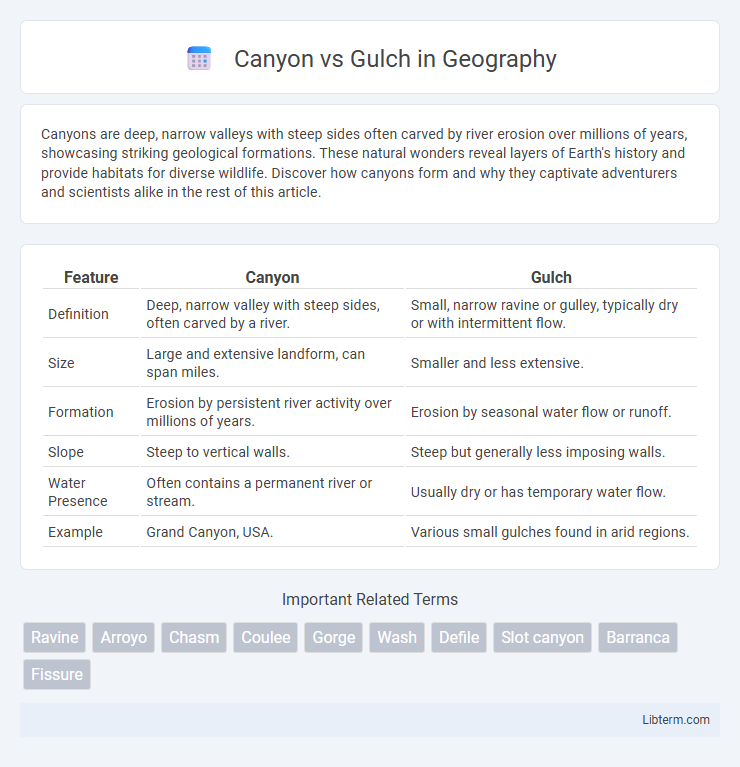Canyons are deep, narrow valleys with steep sides often carved by river erosion over millions of years, showcasing striking geological formations. These natural wonders reveal layers of Earth's history and provide habitats for diverse wildlife. Discover how canyons form and why they captivate adventurers and scientists alike in the rest of this article.
Table of Comparison
| Feature | Canyon | Gulch |
|---|---|---|
| Definition | Deep, narrow valley with steep sides, often carved by a river. | Small, narrow ravine or gulley, typically dry or with intermittent flow. |
| Size | Large and extensive landform, can span miles. | Smaller and less extensive. |
| Formation | Erosion by persistent river activity over millions of years. | Erosion by seasonal water flow or runoff. |
| Slope | Steep to vertical walls. | Steep but generally less imposing walls. |
| Water Presence | Often contains a permanent river or stream. | Usually dry or has temporary water flow. |
| Example | Grand Canyon, USA. | Various small gulches found in arid regions. |
Understanding the Basics: What is a Canyon?
A canyon is a deep, narrow valley with steep sides, often carved by river erosion over millions of years, characteristic of arid and semi-arid regions. It typically features layered rock formations that reveal geological history, contrasting sharply with the wider and more gradual slopes of a gulch. Understanding these distinctions helps in identifying canyons as significant geological structures formed through intense natural processes.
Defining a Gulch: Key Characteristics
A gulch is defined as a narrow, steep-sided ravine often formed by the erosive action of fast-moving water in mountainous or hilly terrain. Typically smaller and shallower than canyons, gulches feature abrupt slopes and may temporarily carry streams during heavy rain or snowmelt. Their distinct geomorphology distinguishes them from broader, deeper canyons which are carved over longer geological periods.
Geological Formation: Canyon vs Gulch
A canyon is a deep, narrow valley with steep rocky walls, typically formed by long-term erosion from a river cutting through resistant rock layers. Gulches are smaller, more shallow landforms, often created by rapid water runoff and less extensive erosion processes, usually found in arid or semi-arid regions. Both formations illustrate the dynamic interaction of water and geological substrates, but canyons exhibit more complex stratigraphy due to prolonged geological activity.
Size and Scale Differences
Canyons are massive geological formations characterized by deep valleys with steep, vertical walls, often extending for miles and reaching depths of thousands of feet. Gulches are much smaller, narrower ravines or gullies carved by water erosion, typically only a few feet wide and shallow compared to the expansive scale of canyons. The sheer size and depth of canyons create dramatic landscapes, while gulches tend to be more localized features with limited spatial impact.
Common Locations and Examples
Canyons commonly form in arid or semi-arid regions like the Grand Canyon in Arizona, characterized by deep, wide valleys carved by river erosion. Gulches are typically found in mountainous or hilly terrains such as the Rocky Mountains, often presenting as narrow, steep-sided ravines with intermittent water flow. Both landforms illustrate significant geological processes shaped by erosion but differ in scale and environmental context.
Erosion Processes: Canyons and Gulches Compared
Canyons and gulches both form through erosion but differ significantly in scale and process. Canyons, typically carved by persistent river flow over millions of years, exhibit deep, wide channels with steep walls, often exposing multiple geological layers. Gulches, smaller and narrower, result primarily from sporadic flash floods or surface runoff, creating sharp but less extensive erosion features.
Ecological Impact on Surrounding Areas
Canyons, typically deeper and wider than gulches, often support diverse ecosystems due to their substantial water flow and varied microhabitats, promoting rich biodiversity. In contrast, gulches are narrower, often ephemeral watercourses that influence local vegetation patterns and soil erosion more transiently, resulting in less stable habitats. Both landforms affect surrounding areas by shaping drainage patterns and nutrient distribution, but canyons tend to have more pronounced long-term ecological impacts on regional flora and fauna.
Recreational Activities: Which is More Accessible?
Canyon hiking trails typically offer more accessibility with well-maintained paths suitable for a wide range of skill levels, including families and casual hikers. Gulches, often narrower and steeper, present more challenging terrain that appeals to experienced outdoor enthusiasts seeking adventure and less crowded routes. Accessibility to recreational activities in canyons generally includes options like bird watching, rock climbing, and guided tours, whereas gulches emphasize rugged exploration and technical climbing opportunities.
Cultural and Historical Significance
Canyons often hold significant cultural and historical value, serving as sacred sites for Indigenous peoples and locations of ancient settlements and rock art, exemplified by the Grand Canyon's deep spiritual connection to Native American tribes. Gulches, while typically smaller and less prominent, have historical importance in local contexts, such as being pathways or water sources for early settlers and explorers in various regions. Both landforms contribute uniquely to understanding human history and cultural practices linked to their geographic features.
Summary: Choosing Between Canyon and Gulch
Choosing between a canyon and a gulch depends on geological features and scale; canyons are large, deep valleys often carved by rivers over millions of years, while gulches are smaller, narrow ravines typically formed by flash flooding. Canyons support diverse ecosystems and offer extensive recreational opportunities such as hiking and rafting. Gulches provide more localized drainage and are common in arid or mountainous regions with rapid water runoff.
Canyon Infographic

 libterm.com
libterm.com